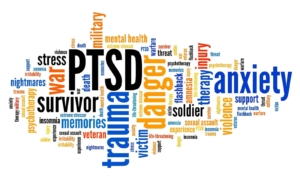What is Dialectical Behavioral Therapy for PTSD? And How Can DBT PE Help?
What is PTSD?
Post-Trauma Stress Disorder (PTSD) is a disorder that develops after someone has experienced, witnessed, or learned about one or more traumatic events. PTSD symptoms can start right away or take time to appear. The intensity of symptoms can vary over time. A professional (online therapist, psychologist, or psychiatrist) will assess your symptoms to see if that fall into four categories and that these symptoms cause distress and can make it hard to function in your daily life.
The four categories that include 20 symptoms are intrusive memories, avoidance, changes in thinking and emotions, changes in arousal and reactivity and some people may experience a fifth category that includes dissociation.
What is Dialectical Behavioral Therapy?
DBT Prolonged Exposure (DBT PE) is for individuals who have PTSD and have high-risk, multi-problem that have created many issues. This includes life-threatening behaviors, multiple or severe comorbid conditions that include personality disorders, substance use disorders, eating disorders, and others. Being high-risk such as multiple visits to the hospital, self-harm behaviors, and increased substance use problems often excludes clients from being able to start traditional PE (Prolonged Exposure). The design of DBT helps the client reduce their high-risk behaviors so they can treat their PTSD symptoms.
Dr. Melanie Harned developed the DBT PE protocol to specifically treat high-risk clients who have PTSD and are receiving DBT. The protocol’s goal with Prolonged Exposure therapy and to adapt it to fit complex client populations with trauma and to build a life worth living. People with PTSD often avoid emotions, thoughts, and situations that remind them of their traumas. DBT PE works by helping clients gradually approach trauma-related memories and situations. By engaging in the DBT PE protocol clients will start to see an improvement of PTSD symptoms and help clients gain more control of life
Stages of DBT Therapy:
DBT consists of four stages of treatment. Stage 1 treatment is standard DBT. For the client, this includes weekly individual therapy, skills group, and between-sessions phone coaching. Stage 1 treatment goals are to reduce and gain control over life-threatening, and other severe behaviors by increasing behaviors skills through the 4 modules of DBT.
Once the client is able to reduce their suffering including gaining control over impulsive and self-damaging behaviors. Plus they will learn coping skills to better tolerance and regulate their emotions, they are ready for stage 2. Stage 2 treatment focuses on treating PTSD with DBT PE while the client is continuing to receive all the other modes of standard DBT.
When the DBT PE protocol is complete the client moves into stage 3 treatment. Stage 3 uses the standard DBT protocols to address any remaining problems. These problems could interfere with the client’s life worth living. This can include improving relationships, increasing productive actives with work or school. While in stage 3 treatment clients increase self-respect and build a life that is no longer full of limits from PTSD.
What is involved in therapy?
For clients to be ready for stage 2 treatment, they need to not have engaged in suicidal behaviors such as overdosing, suicide attempts, or engaging in behaviors that would be considered suicidal rehearsals or self-harm behaviors for at least 2 months. DBT PE sessions are 90-120 min long and can take 2-16 sessions. We determine the number of sessions by progress in treatment. DBT PE uses three primary procedures to treat PTSD. In vivo, Imaginal exposure, and processing. Let’s learn more about the steps in this process.
In Vivo Exposure
In vivo exposure involves confronting situations you avoid in real life. Clients will be asked to visit places, approach people, or do things that remind them of their trauma, feel dangerous, or bring up distressing emotions. By approaching these situations, it will help clients to learn that these situations are not harmful and that they can cope. This will make these situations and situations like them less distressing. Clients are asked to engage in safe situations. Additionally, client homework will be to visit, approach people or do things that remind them of their trauma during the weekly outside of session time.
Imaginal Exposure
Imaginal exposure is describing a traumatic event out loud in therapy sessions. Talking and thinking in detail about what happens to the client regarding their trauma memories will help the memories to become less distressing and overwhelming. By using imaginal exposure and talking in detail about their trauma it will be less likely to come up unexpectedly at other times. It is common for people to have difficulty remembering the details of their trauma. DBT PE can be successful with people whose trauma memories have significant gaps, foggy in places, and fragmented in places. We can use DBT PE if there is some memory of the trauma that you have experienced. Not all the details for the treatment will work. We will record imaginal therapy in session and clients will be given the task of listening to their recordings outside of sessions.
Processing
Processing happens after imaginal exposure. This involves talking with their online therapist about any emotions or thoughts that have come up as a result of doing the imaginal exposure. The goal is to help the client gain a new perspective about their trauma. This leads to less distress and enables change where there are unhelpful patterns in the client’s life because of trauma.
Am I a good candidate for DBT PE?
If you have been wondering what is dialectical behavioral therapy and you’re unsure if it would work for you. You’re in the right place. If you have experienced trauma that creates PTSD symptoms that are creating multiple complex problems. Have you been told by other professionals that you could benefit from DBT treatment? Or have you or are you currently in a DBT program, and your therapist is expressing that you are ready for stage 2 treatment? Perhaps, you have been trying a trauma-focused treatment and it has not been working because you have multiple problems along with PTSD. Ultimately, you’re trying to engage in trauma treatment but it feels difficult or unsafe? Maybe, you are struggling with complex problems that include being suicidal, self-harming, emotional dysregulation, and other difficulties managing or functioning in daily life? If yes, then you are a good candidate for DBT PE.
How do I know if DBT PE is the appropriate treatment for PTSD?
To be able to start DBT PE you need to learn how to stop engaging in suicidal and self-harming behaviors. This is done by being in DBT therapy and learning skills to experience and tolerate intense emotions. We use regular DBT to help people achieve readiness and reach goals so they can receive DBT PE.
What if I have more than one trauma?
Most people who receive DBT PE have multiple traumas and often these traumas began in childhood. We can use DBT PE to treat any type of trauma. Common types of traumas include child sexual and physical abuse, intimate partner violence, rape, and traumatic invalidation. You decide what traumas are causing you the most distress. On average 2-3 traumas are our focus in DBT PE. Often, we find that addressing these traumas leads to significantly fewer PTSD symptoms.
How effective is DBT PE?
Studies have shown that clients who are going through the DBT PE protocol vs those who have trauma and done regular DBT display reliable improvement of 87% vs DBT clients at 49% of clients (Harned et al., 2014; 2021b; Meyers et al.., 2017). Studies also have shown that clients who are going through DBT PE vs DBT 65% of clients remain in diagnostic remission. 28% of people who have trauma and complete DBT only have a diagnostic remission at 28% (Harned et al., 2014; 2021b). Other studies have shown improvements in other problems are related to PTSD such as anxiety, depression, dissociation, and emotional dysregulation.
What else should I know about DBT PE?
There are some risks to doing DBT PE. Although DBT PE has been shown safe and research suggests that people who received DBT PE are less likely to attempt suicide and self-harm more than those who receive DBT some people may experience in the beginning intense distress and an increase of emotional dysregulation. This can cause an increase in urges for certain problem behaviors. If this happens it should last no more than a few weeks. Once your PTSD improves your distress starts to go down.
DBT PE in Los Angeles, CA and Las Vegas, NV Can Help You Work Through PTSD and Trauma.
If you are struggling with PTSD, Trauma, abuse, or assaults and are ready to get support, our DBT therapists are ready to provide just that. Our comprehensive DBT program at our Los Angeles-based therapy practice includes individual therapy sessions, phone coaching, and a skills group to help you learn emotional regulation and other helpful tools. If you are ready to begin DBT to help with self-harm in Los Angeles, CA, follow the steps below.
- Connect with us using the contact form.
- Start getting support from a DBT therapist.
- Begin finding hope and a way to move forward with DBT PE today!
Other Services at the DBT Center of the South Bay
The DBT program offered at our practice located in Los Angeles, CA can help with a variety of mental health struggles. We help those with self-harming tendencies, suicidal thoughts, and isolation, and loneliness. Additionally, we assist those in need of help with managing anger and engaging in healthier family dynamics. Our services are available in-person or online in California and Las Vegas. If you’re ready to receive the support you have been seeking, the DBT Center of South Bay is for you!





